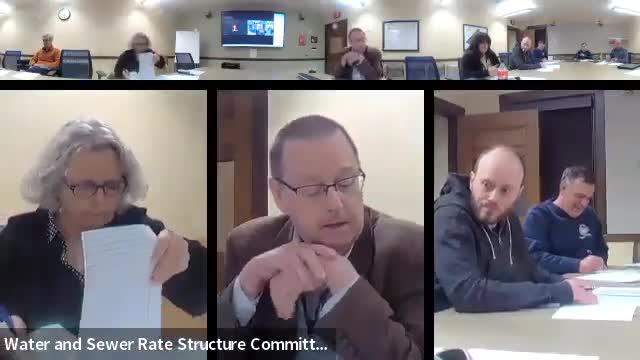Needham committee weighs rate‑structure changes as irrigation bans threaten revenue
March 19, 2025 | Town of Needham, Norfolk County, Massachusetts
This article was created by AI summarizing key points discussed. AI makes mistakes, so for full details and context, please refer to the video of the full meeting. Please report any errors so we can fix them. Report an error »

Town finance and public-works staff told the Water and Sewer Rate Structure Committee on March 18 that projected MWRA assessments and falling irrigation revenue tied to impending state watering restrictions will require changes to Needham’s water and sewer rates.
Dave, a town staff member who presented the financial outlook, said the town is working with a three‑year forecast and that expenses have run about 5.5% higher per year; he said the MWRA assessment is expected to increase and that the town’s 2026 outlook now assumes a 3.5% MWRA increase in the baseline forecast.
Dave summarized revenue targets and example flat-rate equivalents discussed in the meeting: staff said a flat water volumetric rate under one scenario would be $5.05 per hundred cubic feet and a flat sewer rate about $12.59 per hundred cubic feet; staff also estimated aggregate revenue targets for water and sewer in staff materials used at the meeting.
Committee members focused on options to stabilize revenue if irrigation billing falls because of the new watering restriction: raising the fixed (base) fee, shifting more revenue to a larger monthly base charge so that variable consumption changes have less year-to-year impact, or maintaining the existing inclining‑block (step) structure but adjusting step percentages. A staff presenter noted that Massachusetts regulation requires an inclining‑block element for water pricing.
One committee member argued for increasing the fixed charge to reduce volatility in annual revenue, saying a higher base could cover the core fixed costs while limiting year‑to‑year swings caused by changes in irrigation demand. Another member warned that raising a high fixed charge can disproportionately affect low‑use households and that any hardship mechanism would add administrative work.
Staff committed to preparing a limited set of concrete scenarios for the committee’s next meeting rather than the “30 iterations” they said they have run in the past. The committee asked staff to model at least a handful of options including (1) raising the base fee while holding volumetric steps flat, (2) converting more revenue to a larger monthly base that includes a defined volume, and (3) a variation that keeps step differentials but changes step rates to spread impacts.
Calendar and process: staff said the public hearing on rates is scheduled for June 10 and the Select Board is expected to consider adopting rates at its June 24 meeting, with any new rates proposed to take effect July 1.
No formal rate decisions were taken at the March 18 meeting; staff will return with modeled scenarios and updated revenue collections when more recent billing data are available.
Dave, a town staff member who presented the financial outlook, said the town is working with a three‑year forecast and that expenses have run about 5.5% higher per year; he said the MWRA assessment is expected to increase and that the town’s 2026 outlook now assumes a 3.5% MWRA increase in the baseline forecast.
Dave summarized revenue targets and example flat-rate equivalents discussed in the meeting: staff said a flat water volumetric rate under one scenario would be $5.05 per hundred cubic feet and a flat sewer rate about $12.59 per hundred cubic feet; staff also estimated aggregate revenue targets for water and sewer in staff materials used at the meeting.
Committee members focused on options to stabilize revenue if irrigation billing falls because of the new watering restriction: raising the fixed (base) fee, shifting more revenue to a larger monthly base charge so that variable consumption changes have less year-to-year impact, or maintaining the existing inclining‑block (step) structure but adjusting step percentages. A staff presenter noted that Massachusetts regulation requires an inclining‑block element for water pricing.
One committee member argued for increasing the fixed charge to reduce volatility in annual revenue, saying a higher base could cover the core fixed costs while limiting year‑to‑year swings caused by changes in irrigation demand. Another member warned that raising a high fixed charge can disproportionately affect low‑use households and that any hardship mechanism would add administrative work.
Staff committed to preparing a limited set of concrete scenarios for the committee’s next meeting rather than the “30 iterations” they said they have run in the past. The committee asked staff to model at least a handful of options including (1) raising the base fee while holding volumetric steps flat, (2) converting more revenue to a larger monthly base that includes a defined volume, and (3) a variation that keeps step differentials but changes step rates to spread impacts.
Calendar and process: staff said the public hearing on rates is scheduled for June 10 and the Select Board is expected to consider adopting rates at its June 24 meeting, with any new rates proposed to take effect July 1.
No formal rate decisions were taken at the March 18 meeting; staff will return with modeled scenarios and updated revenue collections when more recent billing data are available.
View full meeting
This article is based on a recent meeting—watch the full video and explore the complete transcript for deeper insights into the discussion.
View full meeting
